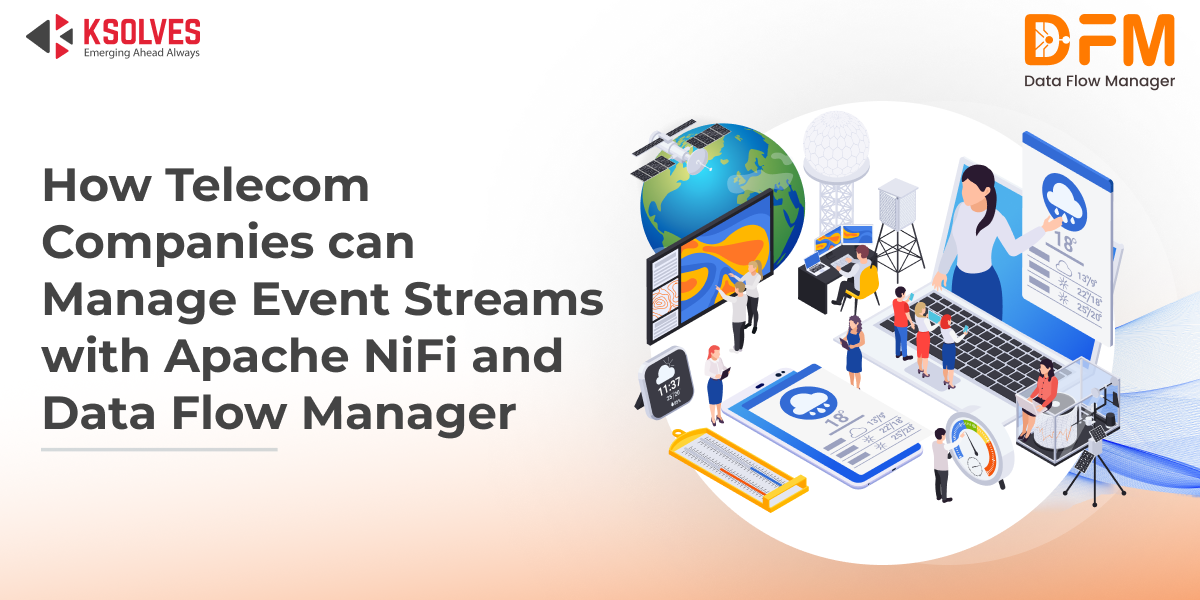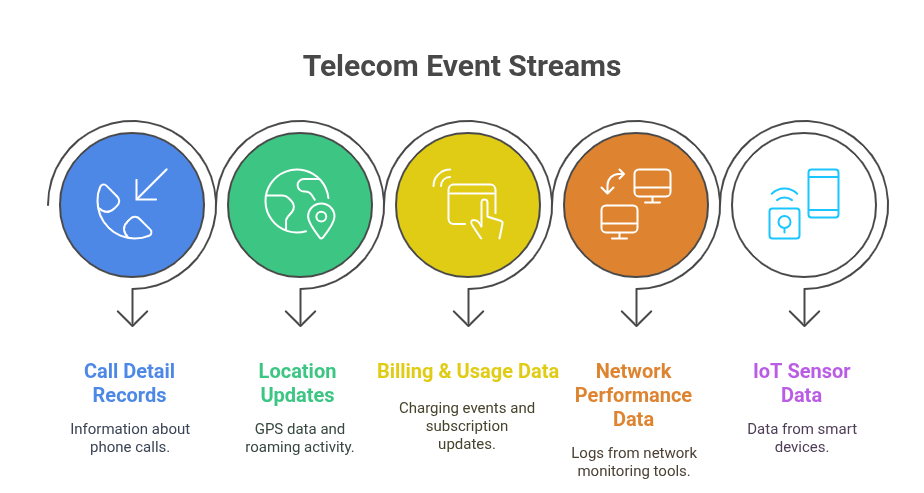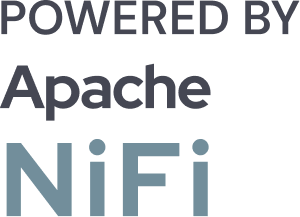Managing Millions of Telecom Event Streams in Real Time with Apache NiFi and Data Flow Manager
![]()

In today’s hyperconnected world, telecom operators face an avalanche of event data flowing from a myriad of sources – mobile towers, billing systems, subscriber devices, and network infrastructure. From call detail records (CDRs) to network logs, every interaction generates a stream of events that must be captured, processed, enriched, and routed in real time.
To stay competitive, telecom companies need the ability to manage these data streams efficiently, ensuring low latency, high throughput, and operational transparency. Traditional data handling techniques fall short when dealing with the velocity and volume of telecom event data. This is where Apache NiFi, a powerful and flexible data integration platform, comes into play.
In this blog, we explore how telecom providers can leverage Apache NiFi to handle event streams at scale, with a focus on architecture, scalability, performance tuning, and real-world use cases.
Understanding Telecom Event Streams
Telecom event streams refer to the continuous, real-time flow of data generated by a telecom network. These streams include:
- Call Detail Records (CDRs): Contain information about phone calls – caller, receiver, duration, location, and more.
- Location updates and mobility events: GPS data, handovers, and roaming activity.
- Billing and usage data: Real-time charging events, subscription updates.
- Network performance data: Logs from switches, routers, and monitoring tools.
- IoT sensor data: From smart devices connected to 5G networks.

These data streams are critical for various operations such as fraud detection, usage analytics, quality of service (QoS) monitoring, and customer behavior modeling. However, managing these at scale involves handling billions of events daily, often in heterogeneous formats and under strict latency constraints.
Why Apache NiFi for Telecom?
Apache NiFi is a powerful data integration tool specifically designed to automate the movement of data between disparate systems. It excels in environments where real-time, secure, and scalable data flow is essential, which makes it a perfect fit for telecom.
Key features include:
- Flow-Based Programming: Design and manage data flows visually through a drag-and-drop interface.
- Data Provenance: Complete lineage of each data element for traceability and compliance.
- Built-in Scalability: Clustered deployment and site-to-site architecture for distributed processing.
- Backpressure and Prioritization: Prevents overload during traffic surges.
- Security First: Includes encrypted data transmission, access control, and audit logs.
- Ease of Integration: Supports out-of-the-box processors for Kafka, HDFS, databases, cloud storage, and REST APIs.
NiFi’s flexibility, observability, and extensibility make it an ideal middleware for telecom data orchestration.
Also Read: 10 Real-World Apache NiFi Use Cases Across Diverse Industries
Architecture for Scalable Telecom Event Stream Management
Managing telecom event streams at scale demands an architecture that can handle high throughput, ensure low latency, and maintain high availability. Apache NiFi fits perfectly into this scenario due to its ability to scale horizontally, provide fine-grained control over data flow, and integrate seamlessly with a variety of data sources and sinks.
Core Architectural Components
1. Data Ingestion Layer
This layer is responsible for collecting data from multiple heterogeneous sources across the telecom network. Typical sources include:
- Apache Kafka: The most common message broker for ingesting real-time streams such as CDRs, SMS events, or network telemetry.
- MQTT Brokers: Lightweight messaging protocol used for IoT device data, including smart meters and 5G-enabled sensors.
- FTP/SFTP: Legacy systems still rely on batch delivery of logs and flat files. NiFi’s processors can poll and fetch these securely.
- Syslog/SNMP Traps: Capture real-time network events and alerts from routers, switches, and firewalls.
- REST APIs / Webhooks: Used for integrating cloud-based services or third-party feeds.

NiFi’s built-in processors (ConsumeKafka, ListenSyslog, GetSFTP, InvokeHTTP, etc.) make it easy to collect data from all these sources concurrently and reliably.
2. NiFi Cluster
The processing engine is a horizontally scalable NiFi cluster, where each node contributes compute capacity to manage growing event volumes. Key features of this cluster include:
- Load Balancing: Incoming flowfiles are evenly distributed across nodes.
- Parallel Processing: NiFi’s non-blocking, multi-threaded architecture allows parallel data flows.
- Backpressure Management: Prevents overwhelming the system during traffic surges.
- Site-to-Site Communication: Enables data exchange between geographically distributed NiFi instances for global telecom deployments.
This setup ensures high availability and fault tolerance, making it ideal for mission-critical telecom operations.
3. NiFi Registry
Managing flow versioning and deployment across environments (Dev → QA → Prod) is crucial for governance and consistency. NiFi Registry offers:
- Version Control: Maintain historical versions of flows, making rollback and comparison easy.
- Collaboration: Allow multiple teams to work on different flows while maintaining traceability.
In large-scale environments, the NiFi Registry ensures that flow designs are standardized and managed efficiently.
4. Storage & Analytics Layer
Once processed, enriched, and routed, event data needs to be stored or forwarded to analytics platforms. Depending on use case and latency requirements, this includes:
- Distributed File Systems: Store raw or enriched data in HDFS or Amazon S3 for archival and batch analytics.
- Real-Time Databases: Feed data into Elasticsearch, Apache Druid, or ClickHouse for real-time dashboards and monitoring.
- Relational Databases: For structured reports, customer care integration, or billing reconciliation (PostgreSQL, Oracle, etc.).
- Stream Analytics Engines: Data routed to Apache Flink or Spark Streaming for complex event processing and pattern recognition.
This layer powers everything from SLA tracking to fraud detection and marketing analytics.
High-Level Data Flow Overview
Let’s walk through how the data moves from source to insight:
- Ingestion
Millions of CDRs and network logs per hour are ingested from Kafka, MQTT, or FTP sources using NiFi’s native processors.
- Parsing & Enrichment:
Use processors like ConvertRecord, UpdateRecord, and LookupRecord to:
- Convert incoming data formats (JSON, XML, Avro, etc.)
- Enrich events with subscriber metadata (from CRM/DB)
- Add calculated fields such as call cost or usage tier
- Filtering & Routing:
Apply business rules using RouteOnAttribute, QueryRecord, and EvaluateJsonPath:
- Example: Route VIP customers to a priority channel
- Example: Separate international vs local call records
- Delivery to Downstream Systems:
Push data to multiple destinations using PutHDFS, PutDatabaseRecord, PublishKafkaRecord, or PutElasticsearchHttp.
Alerts are triggered via webhooks or Kafka topics when anomalies or threshold breaches are detected.
- Feedback Loop & Monitoring:
Route operational metrics and flowfile statuses to Elasticsearch or Prometheus for monitoring and alerting. Use SiteToSiteReportingTask to push system metrics to a central NiFi for observability.

The Role of Data Flow Manager in Scalable Telecom Event Stream Processing
When managing complex telecom data pipelines, efficiency, governance, and scalability are crucial. That’s where Data Flow Manager (DFM) comes into play. It’s a powerful tool designed to streamline the deployment and management of Apache NiFi data flows.
For telecom companies dealing with massive event data streams, Data Flow Manager simplifies the process of deploying and controlling data pipelines without needing to write any custom code.
Let’s dive into how Data Flow Manager adds significant value to telecom event stream processing.
- Code-Free NiFi Flow Deployment
With Data Flow Manager, deploying and promoting NiFi data flows becomes simple and effortless. The platform eliminates the need for writing complex Ansible scripts to deploy your NiFi data flows from one cluster to another. Simply test and deploy them in a few minutes, saving time and effort for your team.
Why it matters: Faster NiFi data flow deployments, less technical overhead, and more time to focus on other critical tasks.
- Schedule NiFi Data Flow Deployments with Admin Approval
Data Flow Manager lets you schedule NiFi data flow deployments for off-peak hours (like during the night) to minimize disruption. But it doesn’t stop there – before a flow is deployed, it requires admin approval, ensuring that only authorized personnel can push flows into production.
Why it matters: Safer, more coordinated NiFi data flow deployments with fewer risks of interruptions during peak hours.
- Version Control & Rollback
Change happens. With Data Flow Manager, every NiFi data flow deployment is versioned, allowing you to track changes over time. If a new flow version causes issues, you can easily roll back to a previous, stable version. This ensures that any unexpected issues won’t derail your entire operation.
Why it matters: Greater flexibility and safety when experimenting with new NiFi data flows or responding to production issues.
- Audit Trails for NiFi Data Flow Activity
In telecom, compliance is a big deal. Data Flow Manager provides complete audit trails for every change made to a NiFi data flow – who deployed it, what changes were made, and when they occurred. This is crucial for audit and compliance purposes, making sure your operations remain transparent and accountable.
Why it matters: Full traceability and compliance with industry standards which is essential in highly regulated telecom environments.
- Role-Based Access Control (RBAC)
In a telecom organization, you often have different teams with varying responsibilities. Data Flow Manager’s Role-Based Access Control (RBAC) ensures that only authorized users can view, edit, approve, or deploy NiFi data flows. This prevents unauthorized changes and strengthens overall security.
Why it matters: Fine-grained control over who can access and modify data flows, ensuring both security and accountability.
How a Telecom Client Reduced Operational Bottlenecks with Data Flow ManagerExplore the Case Study |
Data Flow Manager in Telecom Event Stream Processing at a Glance
Imagine you need to roll out a new data pipeline to track call drop patterns across different regions. Here’s how Data Flow Manager makes it seamless:
- Design and test your NiFi flow in the Development environment in minutes.
- Version the flow and move it to Staging after confirming that it works as expected.
- Schedule the deployment for a late-night window and send it for admin approval.
- Once approved, the flow is deployed to Production, with audit logs captured for compliance.
- If anything goes wrong, you can roll back to the previous version in a matter of minutes, minimizing downtime.
Conclusion
Apache NiFi empowers telecom operators to process massive event streams with agility, precision, and real-time responsiveness. From CDRs to network logs, it handles complex data flows with built-in scalability, fault tolerance, and integration ease. But as data pipelines grow, so does the need for control and governance. That’s where Data Flow Manager steps in.
It simplifies NiFi data flow deployment, enforces version control, and adds audit-ready transparency without writing code. Its scheduling and role-based access features bring safety and structure to high-stakes telecom operations. Together, NiFi and Data Flow Manager deliver a powerful, future-ready foundation. Telecom companies can now innovate faster, operate smarter, and stay confidently ahead.
![]()

